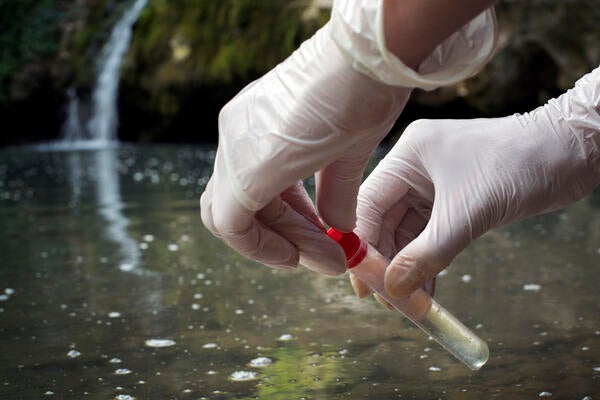
Glass can be a solid and a liquid – at the same time
Ground-breaking research published in Science by Waterloo physicists reveals that solid glass actually has a thin, liquid-like layer

Ground-breaking research published in Science by Waterloo physicists reveals that solid glass actually has a thin, liquid-like layer
By Katharine Tuerke Faculty of ScienceUniversity of Waterloo physicists have succeeded in measuring how the surfaces of glassy materials flow like a liquid, even when they look solid.
“Common sense would tell you that if a material is solid, it’s solid everywhere. But we’ve shown that a solid isn’t a solid everywhere,” says James Forrest, a professor in Waterloo’s Department of Physics and Astronomy. “It’s almost solid everywhere - except a few nanometers at the surface.”
A series of simple and elegant experiments were the solution to a problem that has been plaguing condensed matter physicists for the past 20 years. The experiments revealed that at a certain temperature range, solid glassy materials actually have a very thin liquid-like layer at the surface.
The discovery is important because the nanomaterials used in the experiment have a wide range of possible applications – everything from batteries and LED lights to pharmaceuticals and electronics that we use everyday.
Research published in prestigious journal Science
The work is the culmination of a project carried out by a research team led by Forrest and doctoral student Yu Chai from the University of Waterloo as well as researchers from École Superieure de Physique et de Chimie Industrielles in France and McMaster University.
Their groundbreaking work was published in the prestigious scientific journal, Science, this week.
“Glasses are fascinating materials. At low temperatures they’re solid, and at higher temperatures they’re liquid. At intermediate temperatures, it’s hard to consider them as only one or the other,” said Forrest. “Surfaces of glassy polymers shouldn’t flow below the glass transition temperature, but they do. The question is why.”
Research applies to all glassy materials – metals and polymers too
Glass is much more than the material in bottles and windows. In fact, any solid without an ordered, crystalline structure is considered a glassy material, so metals, small molecules, and polymers can all be made into glassy materials.
Polymers, the building block of all plastics, are almost always glassy rather than crystalline. These materials undergo a transition between a brittle solid and a molten liquid in a narrow temperature range, which encompasses the so-called glass transition temperature.
In a series of experiments, Forrest and colleagues started with very thin slices of polystyrene stacked to create tiny staircase-like steps about 100-nanometres high – less than 0.001 per cent the thickness of a human hair. They then measured these steps as they became shorter, wider and less defined over time.
The simple 2-dimensional profile of this surface step allowed the physicists to numerically model the changes to the surface’s geometry above and below the glass transition temperature.
Results show that above the transition temperature, polystyrene flows entirely like a liquid; but below this temperature the polymer becomes a solid with a thin liquid-like layer at the surface.
Forrest is also a University Research Chair, a member of the Waterloo Institute for Nanotechnology and an associate faculty member at the Perimeter Institute.
The project team also includes Kari Dalnoki-Veress and J.D. McGraw from McMaster University and Thomas Salez, Michael Benzaquen and Elie Raphael of the École Superieure de Physique et de Chimie Industrielles in Paris.

Read more
Waterloo research is leading the fight against an invasive plant threatening Ontario wetlands

Read more
Wastewater monitoring indicates early upward trends in COVID-19 and Influenza

Read more
The InnoHK Centre for Eye and Vision Research aims to bring eye and vision research to market through Waterloo-Hong Kong partnership
The University of Waterloo acknowledges that much of our work takes place on the traditional territory of the Neutral, Anishinaabeg, and Haudenosaunee peoples. Our main campus is situated on the Haldimand Tract, the land granted to the Six Nations that includes six miles on each side of the Grand River. Our active work toward reconciliation takes place across our campuses through research, learning, teaching, and community building, and is co-ordinated within the Office of Indigenous Relations.